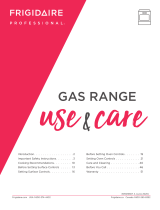
7
IMPORTANT SAFETY INSTRUCTIONS
IMPORTANT INSTRUCTIONS FOR USING
YOUR GAS COOKTOP
Know which knob or key controls each surface
heating area. Place cookware with food on the
cooking area before turning it on. Turn the
cooking area off before removing the cookware.
Use proper pan size. This appliance is equipped
with one or more surface units of different sizes.
Select cookware with flat bottoms that match the
surface unit heating element. The use of under-
sized cookware may expose a portion of the
flame to direct contact and may result in the
ignition of clothing or other items. Using the
proper cookware on the cooking areas will
improve efficiency.
Always turn knob to the full LITE position when
igniting top burners. Visually check that burner
has lit. Then adjust the flame so it does not
extend beyond the edge of the utensil.
To reduce the risk of burns, ignition of flammable
materials, and spillage due to unintentional
contact with the utensil, the handle of the utensil
should be positioned so that it is turned inward,
and does not extend over adjacent surface
burners.
Never leave surface burners unattended at high
heat settings — Boil overs cause smoking and
greasy spill overs that may ignite, or a pan that
has boiled dry may melt.
Glazed cooking utensils — Only certain types of
glass, glass/ceramic, ceramic, earthenware, or
other glazed utensils are suitable for cook top
service without breaking due to the sudden
change in temperature. Check the manufacturer’s
recommendations for cook top use.
When you are flaming foods under a ventilating
hood, turn the fan on.
IMPORTANT INSTRUCTIONS FOR USING
YOUR OVEN
Protective liners—Do not use aluminum foil, after-
market oven liners, or any other materials or
devices to line oven bottom, oven racks, or any
other part of the appliance. Only use aluminum as
recommended for baking, such as lining
cookware or as a cover placed on food. Any other
use of protective liners or aluminum foil may
result in a risk of electric shock or fire or a short
circuit.
Do not touch surface burners or elements,
areas near these burners or elements, interior
surfaces of the oven, or the warmer drawer (if
equipped). Surface burners and elements may
be hot even though they appear cool. Areas
near surface burners and elements may
become hot enough to cause burns. During and
after use, do not touch, or let clothing or other
flammable materials touch these areas until
they are cool. These areas may include the
cooktop, surfaces facing the cooktop, oven vent
areas, oven door, and oven window.
Do not attempt to operate the appliance during
a power failure. If the power fails, always turn off
the appliance. If the appliance is not turned off
and the power resumes, electric surface
elements may resume operation when power is
restored. Once the power resumes, reset the
clock and the oven function.
Use Proper Flame Size — Adjust flame size so
it does not extend beyond the edge of the
utensil. The use of undersized utensils will
expose a portion of the burner flame to direct
contact and may result in ignition of clothing.
Proper relationship of utensil to flame will also
improve efficiency.




















